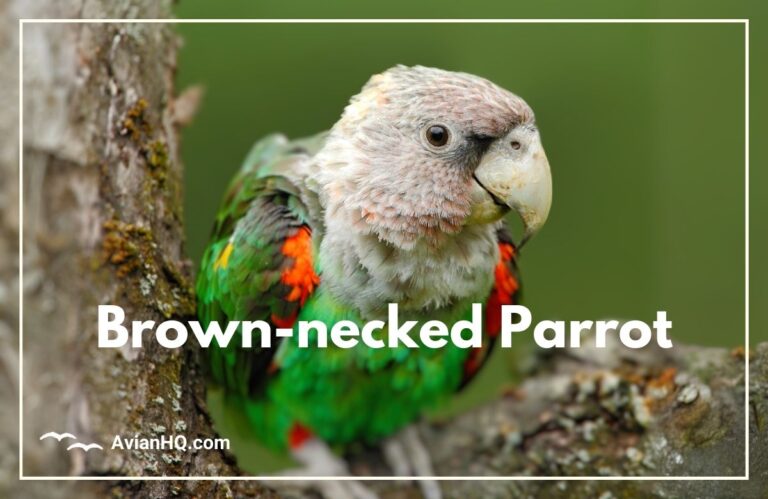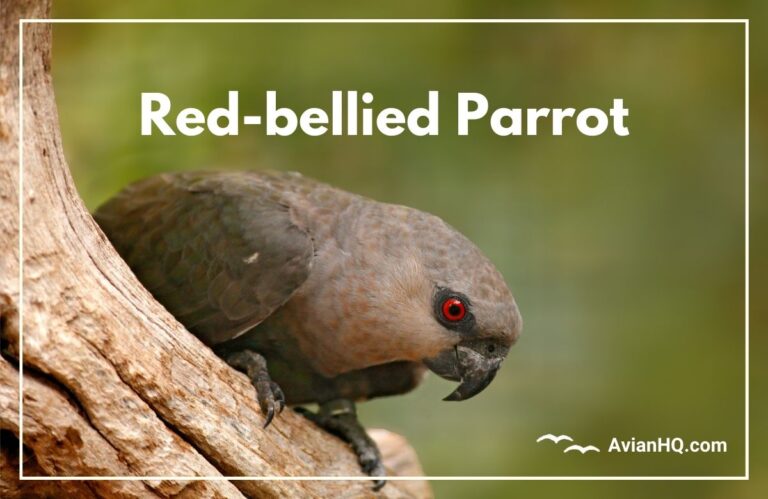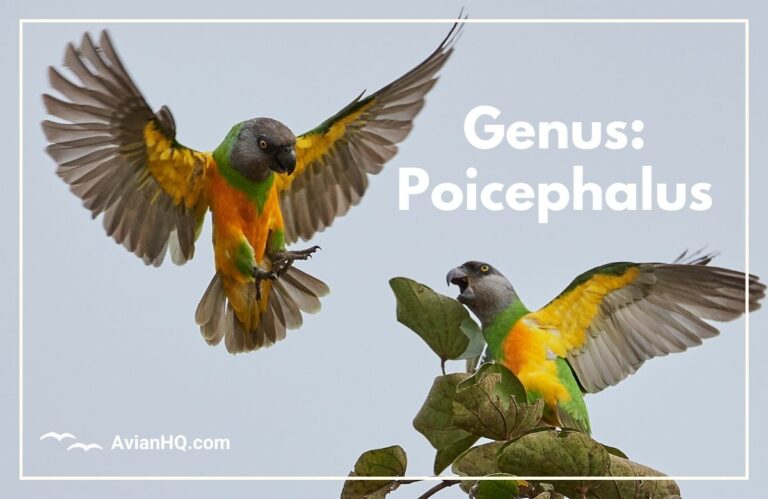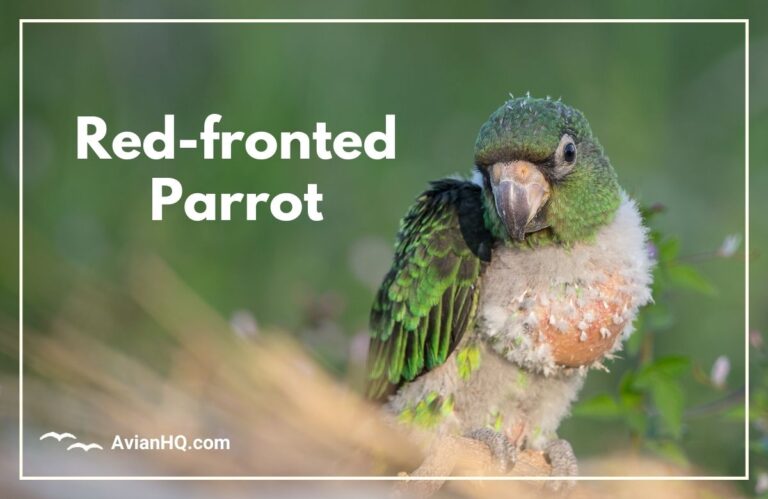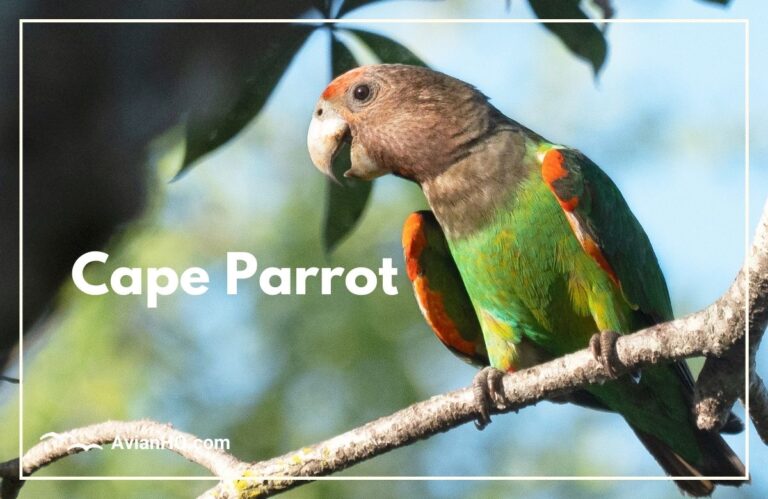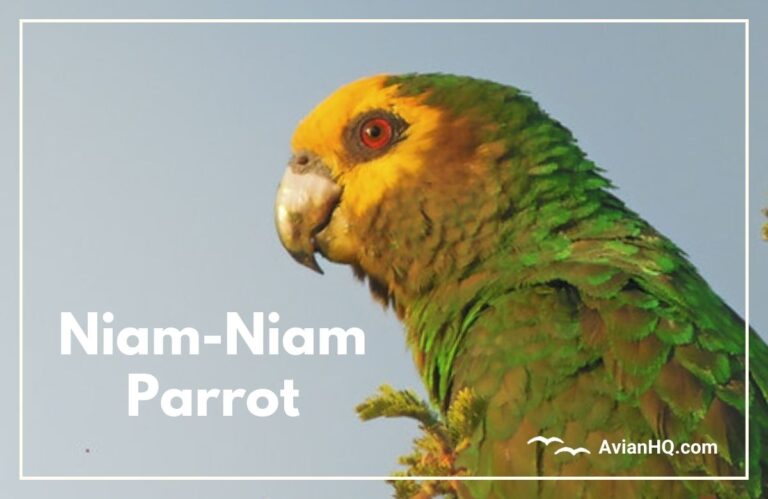Meyer’s Parrot (Poicephalus meyeri)
The Meyer’s Parrot, sometimes called the Brown Parrot, is a small African parrot that is growing in popularity as a pet. Though not as brightly colored as some of it’s relatives, the Meyer’s Parrot makes up for it with an endearing personality. While a fairly common species overall, some populations of the Meyer’s Parrot have decreased due to habitat loss and trapping for the pet trade.
If you are considering getting a Meyer’s Parrot, familiarizing yourself with these birds will help you meet their needs. Below you will find details on their origins, appearance, behavior, care requirements, and conservation status. With the right environment, a Meyer’s Parrot can make a sweet and charming companion.
Scientific Background
The Meyer’s Parrot is named after the German ornithologist Bernhard Meyer. It was first described scientifically in 1827 by Philipp Jakob Cretzschmar, a German doctor and avian expert of his era.
Six subspecies of the Meyer’s Parrot are recognized today. They are distinguished by slight differences in their plumage and geographic distribution across sub-Saharan Africa. We will cover this topic in detail further down in the article.
In the wild, Meyer’s Parrots inhabit various woodland habitats and can adapt quite well to deforested areas and agriculture. Their flexibility likely contributes to the species remaining widespread and abundant over much of it’s range. Yet in some regions, habitat loss and trapping for the pet industry has led to decreased numbers locally.
Overall however, the species is classified as Least Concern by the IUCN Red List. And for those interested in owning one of these charismatic parrots, acquiring a captive-bred bird helps reduce pressure on wild populations.
Physical Appearance
The Meyer’s Parrot has an average length of about 21 centimeters (8.25 inches) and weighs between 90-130 grams (3.1-4.6 ounces). Compared to some parrots, their plumage may seem dull being mostly brown, gray, and green. Yet they still have appealing color accents.
Plumage and Markings
Adult Meyer’s Parrots have primarily gray-brown heads, necks, backs, and tails. Their bellies are a greenish-blue merging into a brighter blue rump. Yellow markings are often present too, though the extent varies:
- Many have yellow stripes across the crown of their head.
- Yellow splotches frequently occur on the bend of the wings.
- A yellow wash can be found on the leg feathers or “pants” in some.
The flight feathers on the undersides of the wings are pale gray with a yellow tint. The tail and most of the wings are dark brown.
Eye color ranges from orange to blood-red. The bare skin of the face and beak cere is gray-brown. Leg color varies from light to darker shades of gray.
Differences Between Subspecies
As mentioned, the amount and intensity of the yellow markings differs between Meyer’s Parrot subspecies. For example:
- P. m. damarensis and P. m. reichenowi largely lack a yellow stripe on the crown.
- P. m. transvaalensis sometimes has little to no yellow on the crown either.
The yellow leg “pants” also vary in their presence and vibrance between subspecies. Belly and rump color ranges from more turquoise to a purer blue in tone.
Overall however, the subspecies look quite similar despite these moderate variations in color pattern.
The juveniles resemble the adults but have duller green-brown plumage initially. They lack the bright yellow markings that make adult Meyer’s Parrots so charming. These colors develop as the young birds mature.
Habitat and Distribution
Meyer’s Parrots inhabit a broad swath of sub-Saharan Africa. Their native range stretches from central Africa west to east across parts of Chad, Cameroon, Sudan, Ethiopia, Democratic Republic of Congo, Uganda, Kenya, Tanzania, Zambia, Malawi, Mozambique, Zimbabwe, Botswana, Namibia, Angola, and South Africa.
Native Habitats
These adaptable parrots occupy diverse wooded regions including:
- Miombo woodlands
- Acacia savannas
- Riparian forests along waterways
- Woodlands interspersed with grasslands
- Remnant forests adjoining agricultural areas
They occur in both wet and dry tropical forests, residing in areas that receive between 400-1200 mm (16-47 inches) of rainfall annually.
Meyer’s Parrots are found across a wide elevation range up to 2200 meters (7216 feet), though they primarily live at lower altitudes. Their habitat flexibility allows them to succeed despite some land conversion to farms. Yet remaining woodlands are still essential for their survival.
Geographic Variation
The subspecies distributions demonstrate their expansive stretch across Africa:
- P. m. meyeri – Chad, Cameroon, Central African Republic, South Sudan, Ethiopia
- P. m. saturatus – Uganda, Kenya, Tanzania
- P. m. matschiei – Tanzania, Malawi, Zambia
- P. m. reichenowi – Democratic Republic of Congo, Angola
- P. m. damarensis – Namibia, Botswana
- P. m. transvaalensis – Zimbabwe, Mozambique, South Africa
Though some regional populations have decreased, Meyer’s Parrots remain locally common in areas like Zimbabwe, Botswana, and Angola. Their flexibility and vast range maintains the species as a whole. Those interested in the conservation of Meyer’s Parrots should focus attention on preserving areas that sustain important populations.
Diet and Feeding
Meyer’s Parrots are opportunistic, generalist feeders that consume a diverse mix of plant foods. Their wild diet includes:
Primary Food Sources
- Fruit – Figs, mangoes, marula fruit, citrus
- Pods and seeds – Acacia, African willow, sausage tree, pod mahogany
- Tree flowers and nectar
- Cultivated grains – corn, sorghum
They use their strong beaks to crack open hard nuts and seeds. Meyer’s Parrots also occasionally eat some insects for extra protein, especially caterpillars and beetle larvae.
Feeding Behaviors
These social birds forage for food in small groups or pairs, traveling between scattered big trees. They prefer to feed high up in treetops when possible.
At abundant food sources like fruiting trees or crops, up to 50 Meyer’s Parrots may congregate together. But they typically gather in smaller numbers.
During drought periods when resources are scarce, they wander more widely through the landscape seeking sustenance. They help disperse the seeds of many tree and shrub species through their daily movements.
In captivity, Meyer’s Parrots should be provided a varied mixture of seeds, pellets, vegetables, and fruit to replicate their diverse natural diet. This helps keep them healthy through proper nutrition.
Breeding and Reproduction
In the wild, Meyer’s Parrots reach breeding maturity between 3-4 years of age. They nest in tree cavities, relying on old woodpecker holes or natural hollows. Meyer’s Parrots are monogamous, mating with one partner per season.
Nest Sites
Meyer’s Parrots nest high up in treetops preferences, likely for increased safety. They choose deep enough cavities to feel secure while incubating eggs and sheltering young nestlings. Inside, the parents do not construct an elaborate nest, simply relying on wood debris already present.
Clutch Size
The average Meyer’s Parrot clutch contains 2-4 white eggs. The female incubates them while the male regularly brings food.
Incubation and Development
Complete incubation takes 26-28 days. The altricial young hatch blind and helpless, covered in sparse gray down. Both parents devote themselves fully to collecting food and feeding the chicks.
After about 9 weeks, the juvenile Meyer’s Parrots are ready to fledge from the nest. They resemble drabber versions of the adults initially. The fledglings stick close to their parents during the post-fledging period to learn skills like foraging, roosting, and avoiding predators.
Seasonal Differences
Breeding seasons vary across the Meyer’s Parrots range:
- April-May in Zimbabwe and Botswana
- March-June in South Africa
- May-September in Zambia, Angola, Malawi
- December-January in Sudan
- April-October in Ethiopia
Their flexibility in timing likely helps them take advantage of seasonal food abundances in their localized areas. This aids productive breeding to offset losses and maintain high numbers.
Behavior and Ecology
Social Structure
Meyer’s Parrots are highly social birds that remain in small groups year-round. Their flocks usually consist of:
- Pairs – Breeding partners stay closely bonded
- Family units – Parents with multiple generations of offspring
- Small feeding flocks – Loose congregations that forage together
They roost communally at night, selecting large tree hollows or cavities that can accommodate higher numbers sleeping side by side. Social roosting helps provide safety in numbers.
Roosting and Movement
During the day, subgroups break off to search for food before reuniting to roost. Meyer’s Parrots remain quite vocal in flight, calling out to maintain contact. Their short rounded wings provide good maneuverability between trees.
Pairs may stake out individual nesting territories within the larger home range. But Meyer’s Parrots are not highly territorial overall, overlapping their living spaces with other flocks.
Interactions with Other Species
Meyer’s Parrots socialize frequently with their own kind while moving between feeding and roosting areas. But they also associate with other bird species at times.
Mixed foraging flocks containing various hornbills, starlings, and other parrots may form where food is abundant. These loose interspecies aggregations help all participants find meal sites while allowing for enhanced vigilance against potential threats.
Overall, the Meyer’s Parrot has a very dynamic social lifestyle. Their bonds with life-long mates, offspring, and flock-mates support an intricately connected society. Their populations remain woven into the rich fabric of diverse African woodland ecosystems.
Conservation Status
The Meyer’s Parrot is evaluated as Least Concern on the IUCN Red List of Threatened Species. This indicates it faces no immediate higher risk of extinction. Their abundant numbers and vast range across over 6 million square kilometers helps secure the species currently.
Yet localized populations have diminished in some areas due to:
- Habitat loss from agriculture and logging
- Capture for the pet trade
- Persecution as crop raiders
Population Estimates
Comprehensive Meyer’s Parrot population surveys are lacking across their expansive habitat. But regional counts provide insight:
- 50+ birds may flock at prime food sources
- 100,000+ likely in Okavango Delta, Botswana based on density extrapolations
- 1 million+ estimated in Zimbabwe
Captive breeding of Meyer’s Parrots for pets has increased recently, which could help satisfy market demands with less trapping pressure on wild populations.
Conservation Efforts
While not currently endangered, protecting areas of remaining savanna and riparian woodlands can help Meyer’s Parrots. Wildlife reserves aim to conserve intact habitats. Additionally, shade-grown agricultural schemes help provide fragments of usable habitat adjacent to crops.
Sustainable harvesting restrictions could be warranted if certain populations show excessive declines from the pet trade. And crop protection education programs may help reduce persecution of Meyer’s Parrots by farmers.
For now, Meyer’ Parrots maintain large resilient numbers across Africa. But continued habitat and population monitoring is vital for the future as anthropogenic pressures keep mounting.
Cultural Significance
Beyond their ecological roles in Africa’s woodlands, Meyer’s Parrots also have significance to humans. Their importance includes:
Use as Pets
- Meyer’s Parrots are increasingly popular as pets due to their charming personalities and moderate size.
- Their laid-back temperaments and lack of loud noisy calls makes them suitable for apartments.
- Captive breeding helps provide pets without reducing wild populations when done responsibly.
Impacts on Agriculture
- Some farmers view Meyer’s Parrots as pests for raiding grain crops.
- Persecution still occurs in retaliation for crop damage, though education programs can help mitigate conflicts.
- Alternate food sources near farms could help reduce crop losses.
Roles in Folklore
- Like many birds, Meyer’s Parrots perhaps featured in indigenous African folk tales and mythology.
- Their small size but social, human-like bonds may have helped them garner anthropomorphic wisdom in traditional stories.
- Protecting forests that sustain Meyer’s Parrots helps preserve elements of West and Central African cultural heritage.
Overall, Meyer’s Parrots have an undervalued but enduring connection to humans across parts of Africa. Safeguarding wild populations while supporting captive breeding promotes their future coexistence with people.
Conclusion
In review, Meyer’s Parrots are adaptable, gregarious African parrots that thrive in small flocks across various woodland habitats. They form life-long bonds between mating pairs and with offspring that underline their social nature. A diverse generalist diet lets them exploit many food sources.
While overall still abundant, some local Meyer’s Parrot populations have decreased from habitat loss and trapping pressures. Their range spans over 6 million square kilometers helping secure the species’ near-term future. But conservation of remaining woodlands is crucial for supporting local numbers.
For bird enthusiasts, Meyer’s Parrots offer appeal as endearing captives, though only captive-bred birds should be acquired as pets. Their quiet tendencies make them suitable for apartments when properly cared for.
From central Africa’s riparian forests to the miombo woodlands of southern Africa, Meyer’s Parrots beautifully embody the contrasts of their environments. Protecting wild populations while supporting responsible captive breeding allows these distinctive parrots to persist.


